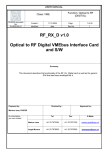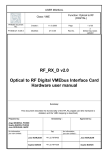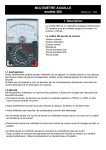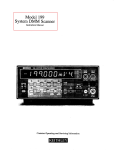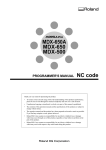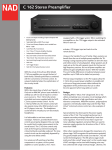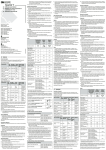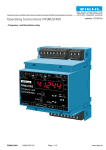Download User Manual - TTC Upgrade
Transcript
USER MANUAL Function: Optical to RF (DIGITAL) Class: VME PH/ESS document No: PH-ESS-02-01 Created : 11.10.2006 Modified: date Page Rev.No. 1 of 17 1 RF_TX_D v1.0 RF to Digital Optical VMEbus Interface Card and S/W Summary: This document describes the functionality of the RF_Tx_Digital card as well as the generic S/W that has been developed for it. Prepared by : Checked by : Approved by : Markus Joos, PH/ESS for information, you can contact : Tel. Fax. E-Mails Markus Joos +41.22.7672364 +41.22.7671025 [email protected] Angel Monera +41.22.7678925 +41.22.7678925 [email protected] PH/ESS Document. No. PH – ESS – ## – ## Page Rev. No. 2 of 17 1 Table of Contents 1. Introduction ........................................................................................................................... 3 2. RF_TX_D Hardware............................................................................................................... 4 2.1. Power description ........................................................................................................................ 4 2.2. Optical Interface ........................................................................................................................... 5 2.3. VMEbus interface ......................................................................................................................... 7 2.3.1. Addr module sellection ................................................................................................................................8 2.3.2. Software: Vme addres map .........................................................................................................................9 2.3.3. Registers Description...................................................................................................................................9 2.3.3.1. EDA Identification .................................................................................................................................9 2.3.3.2. Reference Power threshold..................................................................................................................9 2.3.3.3. Power monitoring registers.................................................................................................................10 2.3.3.4. VRef Registers ...................................................................................................................................11 2.3.3.5. Tx_Enable registers............................................................................................................................12 2.3.3.6. Board Identification.............................................................................................................................13 2.4. Calibration procedures.............................................................................................................. 14 2.5. Board configuration Jumpers and switch ............................................................................... 15 2.6. Fibre / cable connections .......................................................................................................... 15 2.7. Front-panel LEDs ....................................................................................................................... 16 2.8. References or more information............................................................................................... 16 3. TTC common software ....................................................................................................... 17 3.3. 3.3.1. 3.3.2. Introduction ................................................................................................................................ 17 H/W Environment.......................................................................................................................................17 S/W Environment .......................................................................................................................................17 3.4. Test programs ............................................................................................................................ 17 3.5. The user library .......................................................................................................................... 17 PH/ESS Document. No. PH – ESS – ## – ## Page Rev. No. 3 of 17 1 1. INTRODUCTION The RF_TX_D (RF to digital Optical VMEbus car) is an interface card developed as triple optical transmitter. The two boards used together provide 3 digital optical channels, with an 1bit analog to digital converter (comparator), and output LVPECL ac coupled*. This document contains a hardware description of the board and all accessible registers of the RF_TX_D card as well as description of the generic S/W that has been developed for this card. At the end of this document, some basic examples of configuration procedures are proposed. PH/ESS Document. No. PH – ESS – ## – ## Page Rev. No. 4 of 17 1 2. RF_TX_D HARDWARE 2.1. POWER DESCRIPTION This board requires a VME crate with the standard VME64 power supply, with 12, -12, and 5 Volts available. The nominal consumption for these lines is: Voltage Current (A) Fuse Current 5V 650mA 1.5A +12V 30mA 0.1A -12V 30mA 0.1A Table 2.1: Power consumption In order to check the power supplied to the board, three LEDs have been installed to indicate the presence of +12V, -12V and +3.3V* (generated from +5 V, indicating with this light both voltages). *If this LED is not lighting, proceed checking the +5V fuse state. PH/ESS Document. No. PH – ESS – ## – ## 2.2. Page Rev. No. 5 of 17 1 OPTICAL INTERFACE The Optical interface is composed of three equal blocks based on two laser modules that use the same footprint and connection diagram. Each laser module is recommended to transmit a specific frequency range. LASER MODULE Recommended Frequencies Notes OCP STX 03 From 0 to 100 MHz Up to 500 MHz (>250Mhz: out of specs) OCP STX 24 From 0 to 400 MHz Up to 600 MHz Expensive Photodiode, recommended only to ensure 400MHz Transmissions Table 2.2: Signal supported for each Laser module Each channel admits analog or digital input through a coaxial SMA connector and offers an Optical output through a ST/PC connector. Immediately after the coaxial connector, there is a capacitor that blocks the DC component of the signal. This capacitor can be removed in order to make a full DC coupled channel. Picture 2.2.a: Location of Input Capacitor PH/ESS Document. No. PH – ESS – ## – ## Page Rev. No. 6 of 17 1 In order to control and monitor the Tx module, an AD and DA converters have been installed in the purpose of controlling the Reference value of the comparator and monitoring the power of the Laser during the transmission. SMA CONNECTOR PECL COMPARATOR LASER MODULE ADC Power monitoring Tx_Enalble DAC Comparator Reference Control Picture 2.2.b: Optical Interface Diagram Picture 2.2.c: Optical Interface schematic FPGA PH/ESS Document. No. PH – ESS – ## – ## 2.3. Page Rev. No. 7 of 17 1 VMEBUS INTERFACE The VMEbus interface of the RF_TX_D cards is implemented in its FPGA and based on a VHDL Module developed by the AB/RF group. This Module has been developed especially for VME64 but adapted for using some functionality of VME64X (like automatic addressing). The firmware installed has been configured to work in the addressing mode of: A24/D16 and works as a memory decoder, where all the memory space is available. The access modes (dictated by address modifier) are only available for 0x39 and 0x3D, where the there is no distinction between privilege user and normal user From this 24bits of memory address, 6 bits are used for the module address [A23 to A18]. This address can be set up using the two rotary switches. SW1 SW2 Picture 2.3: Module address selector In addition, it is possible to fix automatically the module address by using the geographical address of VME64x. In order to select the source of the module address (rotary switches or GEO addr.), from the 8 bits of the R.S. the 2 lower bits are designated to select it. PH/ESS Document. No. Page PH – ESS – ## – ## Rev. No. 8 of 17 1 2.3.1. ADDR MODULE SELLECTION Address space available: Note: M represent XXXX (any combination of 4 bits) N represent XX (any combination of 2 bits) 0xM(N+0)0000 to 0xM(N+3) FFFF Rotary Switch 1 Rotary Switch 2 M Bits(3:2)= N Bits(1:0)= “1 to 3” M Î 256 Kbytes of memory Module address (MA) Automatic GEO Address (5bits + 0)* [A23…A19] <= GEOGA(4 : 0) A18 <= 0 Bits(3:2)= N 0xMN Manual Address Bits(1:0)= “0” [A23…A20] <= M [A19…A18] <= N *Requires VME64X crate Table 2.3.1: Address and ADDR Mode selection In others words, the bottom rotary switch (sw1) controls the addressing mode with the lower two bits, which switches to automatic mode if the b(0) or b(1) = 1. Examples: Rotary Switch 1 Rotary Switch 2 0xF 0 Module MODO / ADDRESS / SPACE Manual address Module address: 0xF0 0000 Board space: 0xF00000 to 0xF3 FFFF 0xF 1 Automatic address Module address: Depends on the slot into which the card is plugged 0xF 4 Manual address Module address: 0xF4 0000 Board space: 0xF40000 to 0xF7 FFFF Table2.3.1.b: Examples of Module Addr PH/ESS Document. No. Page PH – ESS – ## – ## 9 of 17 Rev. No. 1 2.3.2. SOFTWARE: VME ADDRES MAP Offset Size (bytes) Function Mode Remarks 0x0000 2 EDA ID Read 0x1380 0x0002 2 REF_POWER_COMPARATO R Read/Write 0x000A 2 CH1_ POWER Read 0x000C 2 CH2_ POWER Read 0x000E 2 CH3_ POWER Read 0x0010 2 CH1_REF (COMPARATOR) Read / Write 0x0012 2 CH2_REF (COMPARATOR) Read / Write 0x0014 2 CH3_REF (COMPARATOR) Read / Write Default for pulse transmission 0x0020 2 TX_ENABLE Read/Write Enable Transmitters (bits 1 to 3) 0x003A 2 BOARD ID (CERN ID) Read 0x016D Others Default for pulse transmission Unused Table 2.3.2: VME Memory Map 2.3.3. REGISTERS DESCRIPTION 2.3.3.1. EDA IDENTIFICATION Name Offset Size Access EDA ID 0x0000 16 bits R The card ID is just a register that can be used to identify the board. This default value is 0x1380, which correspond to the EDA project number of the board 2.3.3.2. REFERENCE POWER THRESHOLD Name Offset Size Access REF_POWER_COMPARATOR 0x0004 16 bits (8bits used) R/W The reference Power threshold is a register used as reference to be compared to the power that the laser is transmitting. The result of the comparison is indicated in the front panel with a LED (Green light indicates power emitted > Power threshold, Red light indicates the opposite). PH/ESS Document. No. Page PH – ESS – ## – ## 2.3.3.3. Rev. No. 10 of 17 1 POWER MONITORING REGISTERS Name Offset Size Access CH1_POWER 0x000A 16 bits (8bits used) R CH2_POWER 0x000C 16 bits (8bits used) R CH3_POWER 0x000E 16 bits (8bits used) R The data contained in this registers are obtained by the digitalisation of the signal generated by the power monitoring output (see reference notes of OCP-STX). The purpose of these registers is to evaluate the evolution of the lasers’ power emissions. At the same time, their values indicates if the lasers are transmitting of not. The expected value may change from one photodiode to other, especially if the photodiodes are for different bandwidth. (From OCP STX 03 to stx24 can vary up to 100%) The main idea of monitoring the lasers’ power registers is know the state of the lasers (if they are activated or not) and if they activated, make estimation about the laser state, knowing that the power function is LINEAR and: Laser Module Register State OCP STX 03 & 24 0x0000 Disable or broken OCP STX 03 0x0070 ~0dbm OCP STX 24 0x00E0 ~0dbm Table 2.3.3.3: Normal Lasers’ power registers values Instructions for setting up the Threshold value: − − If the laser is new - Read the registers the first time when a new laser module is connected (time 0): - if the laser is not defective, then, set up the power threshold register around 10% less of the value measured If is not new - Measure the Optical power emitted with a power optical metre - Measure the register and generate a linear approximation to the original values - if the laser is not defective, then, set up the power threshold register around 10% less of the value measured PH/ESS Document. No. Page PH – ESS – ## – ## 2.3.3.4. Rev. No. 11 of 17 1 VREF REGISTERS Name Offset Size Access CH1_REF 0x0010 16 bits (8bits used) R/W CH2_REF 0x0012 16 bits (8bits used) R/W CH3_REF 0x0014 16 bits (8bits used) R/W CHX_REF are a group of register that controls the 1bit ADC situate in the RF input. These registers are 8Bits long and are controlling a linear DAC that will provide a value between 0 and 1.2Volts. This register generates a reference value which is compared to the input signal. As result of this comparison, a PECL square signal will be generated and sent by the laser module, Vref (mV ) = Vref _ value • 4.7mv Where: Vref_value: is the value of the register in decimal Examples: Hex Value Vref Recommended 0x00 5mv For any signal centred in zero, (example 10 to 400Mhz sinusoidal or square signal) 0x70 531mV Recommended for Pulse transmission (1V peak) 0xFF 1.2V Recommended to Block input signal and transmit a permanent 0 0x25 190mv Recommended for Pulse transmission (0.5V peak) Table 2.3.3.4: Example of Vref values and recommendations PH/ESS Document. No. Page PH – ESS – ## – ## 2.3.3.5. 12 of 17 Rev. No. 1 TX_ENABLE REGISTERS Name TX_ENABLE Offset Size Access Default 0x0020 8 bits (bits 3 to 1) R/W 0x0E By default, the lasers are enabled in order to offer a transmission as soon as the board is plugged. It is nevertheless possible to disable the laser transmission when is nor required. Function Bit Function TX1_ENABLE 1 *1 Enable / 0 disable TX2_ENABLE 2 *1 Enable / 0 disable TX3_ENABLE 3 *1 Enable / 0 disable TX1_ENABLE others *0 (not writeable, always 0) * Default values Examples: Hex Value Tx1 En. Tx2 En. Tx3 En. 0x00 0x02 X X X 0x08 0x0A X 0x0C 0x0E Nothing: disable X 0x04 0x06 X: enable X X X X X X X Table 2.3.3.5: Tx_Enalble combinatios PH/ESS Document. No. Page PH – ESS – ## – ## 2.3.3.6. Rev. No. 13 of 17 1 BOARD IDENTIFICATION Name Offset Size Access BOARD ID 0x003A 16 bits R The card ID is just a register that can be used for identify the board… this register is situated in offset 0X003A. Its normal value is 365(decimal), the ESS board number. PH/ESS Document. No. PH – ESS – ## – ## 2.4. Page Rev. No. CALIBRATION PROCEDURES The calibration procedure must be done knowing the signals or using a RF_RX_D board (both boards with VME access) Procedure: - Reset the board or enable the TX writing (0x000E -> all enabled) in Tx_enable Reg - Write 0x10 in all the VREF registers - Do a calibration procedure in the RX_D vme board (see RF_RX_ D user manual) - Identify the signals used or no signal presence… and the receiver used - If the receiver board is full OCP, the signal detection circuit will indicate which channel is working - For knowing the connection diagram between TX_D and RX_D, enable and disable the Lasers and check the frequency variations in RX_D (remember wait 54 seconds between Disable procedure). - After having identified the signal types, adjust the Vref in the Tx boards as is indicated in the following table: Frequency / signals Hex Value Vref clocks or signal centred in 0** 0x00*1 ~0mv Pulses 0x70*2 ~531mV Table 2.4: Calibration Values *1: default in channels 1 and 2 after plug on the board *2: default in channel 3 after plug on the board ** Remember that exist a capacitor in the output that removes the DC component. 14 of 17 1 PH/ESS Document. No. PH – ESS – ## – ## 2.5. Page Rev. No. 1 BOARD CONFIGURATION JUMPERS AND SWITCH Element Description LSB rotary switch See Table x MSB rotary switch See Table x Reset(Front Panel) push button Generate a Soft reset in the FPGA when is pressed ST4 Always ON ST5 Always OFF TP25 Frequency selector0 for the JTAG TP26 Frequency selector1 for the JTAG ST3 If ST3 is ON -> the FPGA will be reprogrammed when the VME crate reset will be activated (Sysreset) Table 2.5: Jumpers and Switch descriptions 2.6. 15 of 17 FIBRE / CABLE CONNECTIONS Connector name To be connected to Format CH1 out Optical Link RF Digital RX Optical: Digital CH1 RF In 50omhs Generator Analog or Digital CH2 Out Optical Link RF Digital RX Optical: Digital CH2 RF In 50omhs Generator Analog or Digital CH3 Out Optical Link RF Digital RX Optical: Digital (to ch3 Pulse default) CH3 RF In 50omhs Generator Analog or Digital (pulse Default in) J5 JTAG JTAG MODE (FPGA) J6 JTAG BIT BLASTER MODE (EEPROM) Table 2.6: Connectors and Descriptions PH/ESS Document. No. PH – ESS – ## – ## 2.7. Page Rev. No. FRONT-PANEL LEDS LED Description VME COMM Indicates if the last VME cycle was successful or wrong ERROR LED Indicates an error in ????? CH1 LED (SD CH1) Indicates Power transmitted > Threshold CH2 LED (SD CH2) Indicates Power transmitted > Threshold CH3 LED (SD CH3) Indicates Power transmitted > Threshold Table 2.7: Front Panel LEDS 2.8. REFERENCES OR MORE INFORMATION Lasers and Photodiodes evaluation (by Angel Monera) EDA documents (https://edms.cern.ch/nav/eda-01380) RF_TX_D TCL console Manual RF_RX_D User Manual 16 of 17 1 PH/ESS Document. No. PH – ESS – ## – ## 3. TTC COMMON SOFTWARE 3.3. INTRODUCTION 3.3.1. H/W ENVIRONMENT 3.3.2. S/W ENVIRONMENT . 3.4. TEST PROGRAMS . 3.5. THE USER LIBRARY Page Rev. No. 17 of 17 1


















